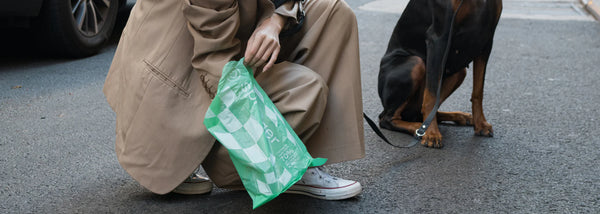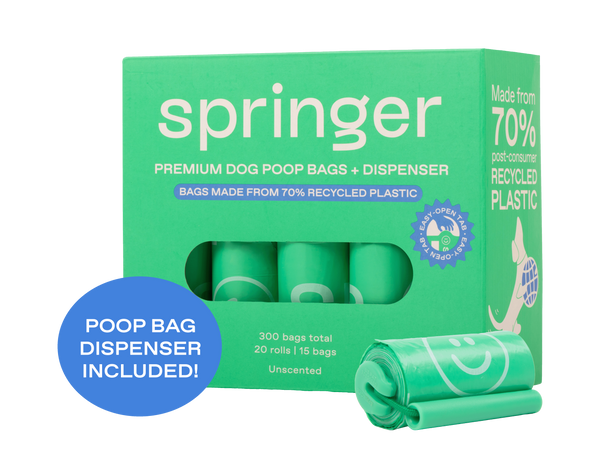Hey, Springer Pack! I’m Ashlee, a photographer, creative director, and self-proclaimed crazy dog lady based in NYC. You’ve most likely seen my photos around Springer’s site and social platforms!
I’ve been a part of the dog rescue community for nearly 15 years. At the age of 12, I started volunteering at local dog shelters. At 21, I rescued my pup Marlow, and a few months after, began my fostering journey!
6 years and about 25 dogs later, I’ve got plenty of tips and tricks to share for how to make the fostering process easier and more rewarding!
Let’s get into it…
Tip #1: Do it for the love of the dogs.
Fostering is hard and messy (and oftentimes smelly) work. If you’re doing this for any other reason than simply wanting to help a dog in need, the tough moments can wear you down quickly.
But if your heart is in the right place, your fostering journey is going to be one of the most fun, fulfilling experiences of your life. Trust.
Tip #2: Find a shelter or rescue that feels right!
Fostering will be a different experience depending on two things - the dog you get, and the shelter or rescue you’re fostering through. Do your research, ask other fosters or shelter/rescue staff questions, and make sure it feels like a good fit!
I’ve found a rescue in my city that I love - sends you home with great supplies, and has a lovely support system of knowledgeable and helpful fosters that step in when needed.
Tip #3: Assess what you can handle to avoid overcommitment.
Properly assess your own skill set - are you comfortable with basic dog training? Do you have prior dog experience? Then you might do well fostering a puppy - which, while adorable, will likely be boisterous and all-around more work. If you’re new to fostering or dogs in general, older dogs are easier.
And lastly, bigger doesn’t always mean more work! Big dogs are oftentimes more mellow and easier to train than some small dogs.
Tip #4: Manage your expectations.
Remember you won’t know much about your dog’s background - I’ve fostered everything from puppy mill breeding moms to dogs that had clearly been abused, or pups that had spent their entire lives in the shelters or were recently left behind when families moved or even passed away.
Each dog could be going through something very different. Give them lots of space and time to decompress, and don’t expect too much from them too fast. While they may not always be the case, these assumptions will help you be prepared for any circumstance:
- Assume you won’t see their true personality for about a week or more. They will need time to get acclimated and open up. Follow their lead on when it’s okay to cuddle them, pick them up, etc. and don’t do too much too fast.
- Assume they are not potty trained. Research + plan accordingly. Pick up nice rugs, have a plan to take them out frequently, maybe try potty pads.
- Assume they are not okay to be left out while you’re gone. Have a crate or baby gates ready. I know, it can feel bad to crate the dogs since they’ve likely just come from a cage, but it’s for everyone’s safety. Dogs are prone to getting into things if they’re not being watched, and you don’t want them tearing something up or eating something dangerous.
- Assume they could have some health issues. Make sure any resident dogs are vaccinated and keep them separate for a few days if possible. But anything like skin irritation, colds, even worms, etc. are quite common and easily treated!
Tip #5: Prepare, but no need to over-prepare!
It can be tempting to want to spoil your new foster with fancy beds and toys right off the bat, I get it. You want to show them how awesome life can be in a home!
However; it’s best to start with the basics. A lot of times, these pups have no experience with or interest in these extras. And since the money for these supplies will largely come out of your own pocket, it’s best to start with the necessities and work up when your dog is showing interest.
Here are some things I always have ready when the dogs come home:
- A small amount of high-quality, nutrient-dense food (not too much, in case they are picky and don’t like it, then you’re stuck with a ton of food that won’t be used)
- Bowls (you can even use your own dishes!)
- Old towels to use for baths and a bed (puppies especially LOVE to pee on or destroy anything that is nice. I wait on fancy beds- they love fluffy washable towels just as much)
- Shampoo (they will likely be stinky)
- Dog friendly travel dog water bottle - for new adventures
- Activities (not necessarily a toy, but my favorite is the WestPaw Toppl, which you can fill with wet food or peanut butter, freeze, and keep your pup busy for hours. Kong's, bully sticks, etc. work too)
- ID Tag (I keep one that just has my name and phone number along with “FOSTER DOG” on it, so that there’s an extra layer of security should anything happen. Some rescues will provide this for you too)
- Harness, collar, and a leash or two (see below)
Tip #6: Double up on street safety!
If you don’t have a fenced yard, you’ll likely be taking your foster dog on walks outside! Some of these dogs have never walked on a leash, and could also be frightened of sights and sounds they come across.
My biggest tip - DOUBLE UP on leads. It’s extra security in case something were to break or come loose, or if your dog wriggles out of it.
- Option 1: A harness + a collar, with a leash on both
- Option 2: A harness OR collar, with a leash, PLUS a slip lead
Tip #7: If you have resident dogs…
Be sure to introduce your foster pup slowly, and on neutral ground outside of the house. Don’t get discouraged if they aren’t immediate friends, they are animals and will need time.
And lastly, be sure to give your resident dog extra love and attention for being such good boys and girls and sharing their home with a dog in need!
Tip #8: You are your dog’s PR team - be a good one.
Put yourself in the shoes of the adopter. What would you want to see? I take lots of pictures and videos, aiming to show the personality of the dog and highlight his best features.
Write a great profile for your dog, describing his favorite and least favorite things, daily activities, etc. so the potential family can see if they would be a good fit!
Tip #9: Be fully transparent with potential adopters, and ask the same from them.
Do not gloss over any quirks or issues your foster dog has. That is a disservice to not only the adopters but the pup as well. You wouldn’t want the dog to be returned because the adopters didn’t know something and didn’t feel equipped to handle it.
At the same time, don’t be afraid to ask your adopters a ton of questions. Your foster is trusting you to vet these people out for them. Some common questions I ask:
- Where will your dog stay while you’re away? Day to day or on trips.
- Where will your dog sleep?
- We don’t know this pup’s full background - what is your plan if any behavioral or health issues pop up in the future?
At the end of the day, trust your gut. You’ll have formed a special bond with your foster and will absolutely know when it’s right.
Tip #10: You will cry when they leave.
You welcomed this sweet creature into your home, gave it love, and showed it how beautiful and pain-free life can be, despite what might have happened in their past. No way around it, you’re going to be sad when the time comes for them to ride off into the sunset and start their new life in a forever home.
But trust that you’ve found a home that’s perfect for them - likely even more perfect than you would be for them. And know that, by opening up that space in your home, you’re able to welcome in the next dog that needs you when the time comes. And that’s a beautiful thing.













